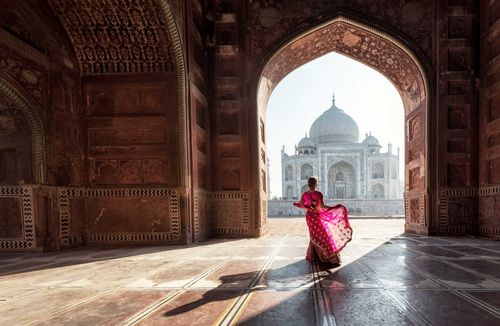Eating in Lucknow
The rich traditional Lucknavi cuisine – featuring Mughlai dishes as well as the local dum pukht (steam casserole) style, sometimes known as handi after the pot it’s cooked in – is available from food stalls throughout the city, in places such as Shami Avadh Bazaar, near the K.D. Singh Babu Stadium, the Chowk, Aminabad and behind the Tulsi Theatre in Hazratganj. Luknavi “kebabs” – extremely delicious – are in fact fried patties of very finely minced meat. The bazaars are the place to get Lucknow’s popular breakfast speciality paya-khulcha, a spicy mutton soup served with hot breads.
Chikan is a long-standing Lucknavi tradition of embroidery, in which designs are built up to form delicate floral patterns along edges on saris and on necklines and collars of kurtas. Workshops can be found around the Chowk, the market area of old Lucknow, and shops and showrooms in Hazratganj (especially Janpath Market), Nazirabad and Aminabad.
Lucknow is also renowned for its ittar (or attar), concentrated perfume sold in small vials – an acquired (and expensive) taste. Small balls of cotton wool are daubed with the scent and placed neatly within the top folds of the ear; musicians believe that the aroma heightens their senses. Popular ittar include ambar from amber, khus from a flowering plant and rose-derived ghulab.
Hazratganj
With its shops and upmarket restaurants and hotels, and a concentration of banks and other services, Hazratganj is the modern centre of Lucknow. Though not as bustling as the older Kaiserbagh and Aminabad neighbourhoods to its west, Hazratganj still has quite a buzz, plus a handful of interesting sights.
Shah Najaf Imambara
With its huge dome, the Shah Najaf Imambara, named after the tomb of Ali in Iraq, is at its best when adorned with lights during the holy month of Muharram. Its musty interior holds some incredibly garish chandeliers used in processions, several tazia, and the silver-faced tomb of the decadent and profligate Ghazi-ud-din-Haidar (ruled 1814–27), buried with three of his queens.
Sikandrabagh
The Imambara was commandeered as an insurgent stronghold in 1857, and the crucial battle that enabled the British to relieve the Residency was fought in the adjacent pleasure gardens of Sikandrabagh on November 16. It took one and a half hours of bombardment by Sir Colin Campbell’s soldiers to breach the defences of the two thousand sepoys; then the Sikhs and 93rd Highlanders poured through. There was no escape for the terrified sepoys, some of whom are said to have believed the bloodstained, red-faced, kilted Scots to be the ghosts of a group of European women slaughtered at Kanpur earlier in the uprising. Driven against the north wall, the sepoys were either bayoneted or shot, and the dead and dying piled shoulder-high. Tranquil once again, Sikandrabagh is now home to the National Botanical Research Institute and the beautiful Botanical Gardens, with manicured lawns, conservatories, nurseries and herb, rose and bougainvillea gardens.
La Martinière
Towards the east of Lucknow, an extraordinary chateau-like building has become almost a symbol of the city – La Martinière remains to this day an exclusive boys’ school in the finest colonial tradition. It was built as a country retreat by Major-General Claude Martin, a French soldier-adventurer taken prisoner by the British in Puducherry. The enigmatic Martin later joined the East India Company, made his fortune in indigo, and served both the British and the nawabs of Avadh. The building is an outrageous but intriguing amalgam, crowned by flying walkways; Greco-Roman figures on the parapets give it a busy silhouette, gigantic heraldic lions gaze across the grounds, and a large bronze cannon graces the front. Martin himself is buried in the basement. During the uprising, La Martinière was occupied by insurgent forces, its boys having been evacuated to the Residency.
The zoo and State Museum
Close to the centre of Hazratganj, its grounds dotted with derelict Avadhi monuments, Lucknow’s small zoo also serves as an amusement park with a miniature train to view the animals. Inside the zoo, the State Museum exhibits delicate, speckled-red-sandstone sculpture from the Mathura School of the Kushana and Gupta periods (first to sixth centuries AD). Besides sculpture from Gandhara, Mahoba, Nalanda and Sravasti, it has a gallery of terracotta artefacts and even an Egyptian mummy. Musical instruments, paintings and costumes provide atmosphere in the Avadh gallery, while the natural history section is a taxidermist’s dream.
The State Museum
Inside the zoo, the State Museum exhibits delicate, speckled-red-sandstone sculpture from the Mathura school of the Kushana and Gupta periods (first to sixth centuries AD). Besides sculpture from Gandhara, Mahoba, Nalanda and Sravasti, it has a gallery of terracotta artefacts and even an Egyptian mummy. Musical instruments, paintings and costumes provide atmosphere in the Avadh gallery, while the natural history section is a taxidermist’s dream.
Hussainabad
In the west of the city, in the vicinity of Hardinge Bridge (or Pucca Pul) around “old” Lucknow, lie several crumbling relics of the nawabs of Avadh. Among them are two particularly impressive imambaras (great halls used for Shi’ite religious commemorations).
Hussainabad Imambara and around
A short distance west of the Rumi Darwaza, the lavish Hussainabad Imambara is also known as the Chhota (small) Imambara, or the Palace of Lights, thanks to its fairy-tale appearance when decorated and illuminated for special occasions. The raised bathing pool in front of it, which is approached via a spacious courtyard, adds to the overall atmosphere. A central gilded dome dominates the whole ensemble, busy with minarets, small domes and arches and even a crude miniature Taj Mahal. Built in 1837 by Muhammad Ali Shah, partly to provide famine relief through employment, the Imambara houses a silver-faced throne, plus the tombs of important Avadhi personalities. The dummy gate opposite the main entrance was used by ceremonial musicians, while the unfinished watchtower is known as the Satkhanda or “Seven Storeys”, even though only four were ever constructed.
Beyond the Hussainabad Tank is the isolated 67m-high Hussainabad clock tower, an ambitious Gothic affair completed in 1887 which carries the largest clock in India. Southwest of the Hussainabad Imambara, and surrounded by ruins, are the two soaring minarets and three domes of the Jama Masjid. Commissioned by Muhammad Ali Shah, who ruled Avadh 1837–42, the mosque was only completed after his death.


_listing_1448379939234.jpeg)




















